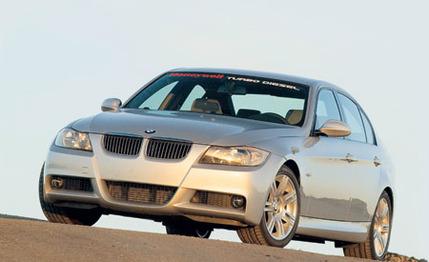 Road Test
Road Test
With the fear that $3 gas is here to stay, American drivers may soon find themselves groping in a panic for more fuel-efficient cars that aren't penalty boxes. A natural alternative is a diesel car. Unfortunately, just as the public is positioned to warm up to the idea of diesel, the government is coming down hard, emissions-wise, on the oil burners.
For an explanation of why diesel cars have a tough row to hoe on their way to the American market, see the sidebar, "The Diesel Dilemma."
Meanwhile, we borrowed a not-sold-here BMW 330d from Honeywell Turbo Technologies to examine the state of the modern European diesel engine. The 330d is of the latest generation of diesels that boast the performance of a gasoline engine with the parsimonious fuel-sipping characteristic of a diesel. With the potential of fuel economy in the mid-40-mpg range and no significant loss in performance, we wanted to see if the 330d could deliver on its seemingly incongruous promises.
It's no secret that the gas-powered 3-series sedans are perennial favorites around here. Witness their 15 10Best trophies since 1992 and a comparison test victory last year ["$35,000 Sports Sedans," C/D, October 2005] as evidence. How would a diesel engine affect our long-term love affair with the 3-series?
Equipped with a 228-hp, 3.0-liter inline-six turbo-diesel engine, the 330d makes less horsepower than the 255-hp, 3.0-liter naturally aspirated gas engine in the 330i. On the other hand, the turbo-diesel engine twists out a massive 369 pound-feet of torque, 149 more than the 3.0-liter gas engine and nine more than the 4.8-liter gas-powered V-8 in the 750i. All that torque is primarily due to the turbo-diesel's high combustion pressures. With that much torque and an easily accessible power curve, the 330d actually felt faster in day-to-day driving.
To test the acceleration of the 330d against its gas-fed counterpart, we headed to the track. In acceleration, the 330d proved to be a near match for the 330i despite its slight power-to-weight-ratio deficit - 13.6 pounds per horse versus the diesel's 15.3. The 228-hp diesel took six seconds to go from 0 to 60, and the quarter-mile fell in 14.5 seconds at 97 mph. A few pounds lighter and packing more horsepower, a 255-hp 330i we tested took 5.6 seconds in the 0-to-60 run and posted a 14.4-second quarter-mile time at 98 mph. It might feel faster, but the 330d is actually a bit slower.
Aside from giving up a few 10ths in the 0-to-60 run, one of the things you'd miss if you opted for the diesel would be the gas engine's terrific sound throughout the rev range, particularly the snarl that is released as the engine crests 5000 rpm. Although the 330d is the best-sounding diesel we've ever heard, that's like saying it's the best American Idol reject.
Another endearing aspect of the gas-fed mill is the way it delivers power in a constant and linear manner all the way to its 7000-rpm redline. In contrast, the diesel has a low 4800-rpm redline, with peak horsepower arriving at 4000 rpm and torque at 1750 rpm. Power comes in abruptly. Below about 1700 rpm, the diesel suffers from a brief moment of turbo lag: Witness the 13.1-second 30-to-50 top-gear acceleration, 3.1 seconds slower than the 330i's. After the lull, all 369 pound-feet hit you like an angry Bill Romanowski. The V-8-like midrange power continues until the peak at 4000 rpm. Rev beyond 4000, and the power tapers off precipitously. From idle to redline, the power delivery is nowhere near as smooth as the 330i's, but keep the revs between 2000 and 4000 rpm, and the punch of the diesel engine will keep you pressed firmly into the seatback.
So the 330d lacks some of the spirit of the gas-engined car, but it also doesn't require as much work, as you can always rely on its midrange punch. Running at the same speed on the same road takes less effort in the 330d. Granted, enthusiastic drivers enjoy working the gearbox, running it up to the redline and generally flogging a willing car, but the diesel's laid-back nature is exactly what increases fuel economy, which soars if the driver keeps the engine revs low, selects higher gears, and rides the 330d's massive torque curve. If you're getting the idea that the diesel engine allows the driver to be a bit less wrapped up in driving the car, you're right.